|
|
|
|
|
Basic Freshwater Tackle
|
|
|
|
Crappie and the Sunfishes
|
|
Jump to;
Lures for Panfish |||
Using Live Minnows |||
Bait for Sunfishes |
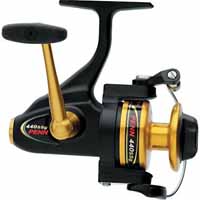  Speckled
Perch and Panfish is where light to
ultra lite spinning tackle in the 4# to
8# catagory really shine. You need to be
able to cast lures as light as 1/32 of
an ounce and be able to cast a lip
hooked minnow without throwing it off.
For crappie, 6# is about as perfect as
it gets. For a rod, get a light action
such as a Shakespeare Ugly Stik Lite,
5'6" rated for 4-8 lb line, 2 piece.
Model SP1156-2L. Match this with a Penn
420ssg reel or equivalent and spool with
4# to 6# line and you are set. 4# will
give better casting distance, especially
with the lightweight lures you will be
using, while 6# may be better if you are
trying to pull crappie out of thick
cover such as a brushpile. If you plan
on doing a lot of fishing for bluegills
and other bream then 4# is definitely
the way to go. Speckled
Perch and Panfish is where light to
ultra lite spinning tackle in the 4# to
8# catagory really shine. You need to be
able to cast lures as light as 1/32 of
an ounce and be able to cast a lip
hooked minnow without throwing it off.
For crappie, 6# is about as perfect as
it gets. For a rod, get a light action
such as a Shakespeare Ugly Stik Lite,
5'6" rated for 4-8 lb line, 2 piece.
Model SP1156-2L. Match this with a Penn
420ssg reel or equivalent and spool with
4# to 6# line and you are set. 4# will
give better casting distance, especially
with the lightweight lures you will be
using, while 6# may be better if you are
trying to pull crappie out of thick
cover such as a brushpile. If you plan
on doing a lot of fishing for bluegills
and other bream then 4# is definitely
the way to go. |
Lures for Crappie and Bluegills
|
|
|
|
While younger crappie will eat a variety
of aquatic insects grubs and other small
forage, as the fish grows, so will its
appetite for various species of minnows
found in our lakes and rivers, and for
the largest fish your choice of baits
and artificial should reflect this.
Below are just a few lures designed for
crappie or bluegills to get you started.
|
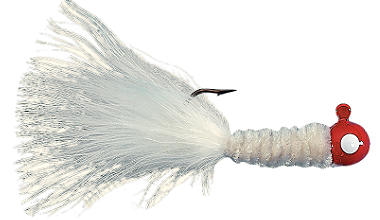 Jigs;
Crappie jigs are made by a variety
of manufacturers and though they are
call crappie jigs they will catch
bluegills and even a few bass as well.
They can be cast and retrieved in
midwater and along the bottom, jigged
from a boat over structure and cast with
a bobber and retrieved. Fish it bare or
tip with a minnow. Comes in sizes 1/8,
1/16, and 1/32. One of the classic lures
of its kind. Jigs;
Crappie jigs are made by a variety
of manufacturers and though they are
call crappie jigs they will catch
bluegills and even a few bass as well.
They can be cast and retrieved in
midwater and along the bottom, jigged
from a boat over structure and cast with
a bobber and retrieved. Fish it bare or
tip with a minnow. Comes in sizes 1/8,
1/16, and 1/32. One of the classic lures
of its kind. |
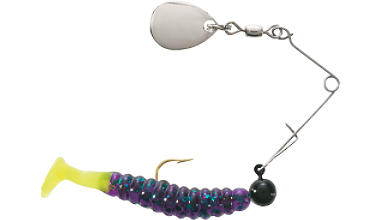 Spinnerbaits;
The spinnerbait style shown at left
with a plastic grub type jig has been
one of my favorite lures for freshwater
ever since I bought my first Beatlespin
lures in the 1970s. Bass, bluegills and
crappie have all fallen for it reliably
enough for me that if I approach a lake
or pond for fishing it is one of the
first lures I will throw. Shown at left
is a Charlie Brewer Crappie Spin, Comes
in one size, 1/16 0z. Spinnerbaits;
The spinnerbait style shown at left
with a plastic grub type jig has been
one of my favorite lures for freshwater
ever since I bought my first Beatlespin
lures in the 1970s. Bass, bluegills and
crappie have all fallen for it reliably
enough for me that if I approach a lake
or pond for fishing it is one of the
first lures I will throw. Shown at left
is a Charlie Brewer Crappie Spin, Comes
in one size, 1/16 0z. |
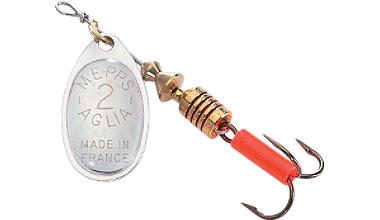 Mepps
Spinner; Invented by French Engineer
Andre Meulnart in 1938, the Mepps
Spinner in its various forms has become
one of the top producing lures in the
world, and one of my favorites. Try the
size 1 or 2 for crappie, the size 0 or 1
for bluegills. Larger sizes can be used
for bass. Word of caution however,
always use a good quality snap swivel
between this lure and your line as it
will cause considerable line twist
otherwise. Mepps
Spinner; Invented by French Engineer
Andre Meulnart in 1938, the Mepps
Spinner in its various forms has become
one of the top producing lures in the
world, and one of my favorites. Try the
size 1 or 2 for crappie, the size 0 or 1
for bluegills. Larger sizes can be used
for bass. Word of caution however,
always use a good quality snap swivel
between this lure and your line as it
will cause considerable line twist
otherwise. |
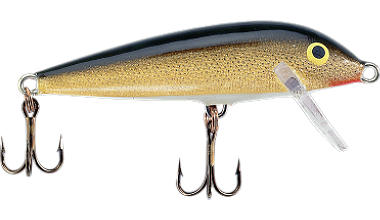 Rapala
Countdown; The two smallest sizes of
this lure can be crappie and panfish
killers. They have a sink rate of about
1 foot per second, meaning you can fish
at a predetermined depth by casting and
then counting seconds before starting
your retrieve. They can be fished as a
crankbait with a steady retrieve or as a
twitch lure. For crappie and bluegills
use either the model CD1 at 1" in length
and 1/16 of an ounce or the model CD3 at
1-1/2" and 1/8 of an ounce. Rapala
Countdown; The two smallest sizes of
this lure can be crappie and panfish
killers. They have a sink rate of about
1 foot per second, meaning you can fish
at a predetermined depth by casting and
then counting seconds before starting
your retrieve. They can be fished as a
crankbait with a steady retrieve or as a
twitch lure. For crappie and bluegills
use either the model CD1 at 1" in length
and 1/16 of an ounce or the model CD3 at
1-1/2" and 1/8 of an ounce. |
Live Minnow fishing for Crappie
|
|
|
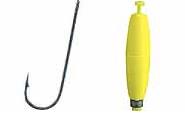 Crappie
are one of the most popular fish in
America and dozens of rigs to present
live minnows to them have been developed
over the years by various crappie
experts. However, we are going to go
with three of the simpler rigs to get
started. Crappie
are one of the most popular fish in
America and dozens of rigs to present
live minnows to them have been developed
over the years by various crappie
experts. However, we are going to go
with three of the simpler rigs to get
started.
When fishing live minnows for crappie,
you need to match the hook size to the
baits you are using in order to get a
natural of a presentation as possible.
These baits are fairly small and a long
shank light wire Aberdeen style hook is
the hook of choice. For baits that are
about an inch or so, use a size 4, while
for baits approaching 2 inches in
length, use a size 2. For fishing with a
float or bobber ther are two types of
floats to consider. For shallower water
or if you are going to suspend a bait at
a depth of under about 3-4 ft, then a
standard clip on float will suffice. I
prefer a torpedo shaped float as small
as I can use without the rig pulling it
under. |
|
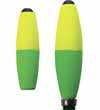 However,
there are many times when you will find
the crappie in deeper water and reaching
the right depth and holding the bait at
that depth can make or break a fishing
trip. Trying to cast a clip on float rig
with 6 or more feet of line between hook
and float can be a real problem. This is
when you may want to consider a Slip
Bobber. Here are the basic steps to
making the rig. However,
there are many times when you will find
the crappie in deeper water and reaching
the right depth and holding the bait at
that depth can make or break a fishing
trip. Trying to cast a clip on float rig
with 6 or more feet of line between hook
and float can be a real problem. This is
when you may want to consider a Slip
Bobber. Here are the basic steps to
making the rig.
1. Pull as much line as you want the
bait to be suspended from the surface
through the guides of your rod.
2. With a piece of string, rubber band,
or piece of fishing line tie a stop knot
at the depth you want around the line
from the rod. Clip the extra line from
the knot leaving just enough for the
knot to hold so that the knot will pass
through the guides of the rod during a
cast.
3. String a stop bead onto your fishing
line and slide it up to the knot.
4. String the Slide Float onto your
line.
5. Tie the aberdeen hook to the end of
your fishing line.
6. Install a split shot weight about 12
- 18 inches above the hook.
For instructions from an expert on
rigging this and other float types
consult the expert of all experts, the
Slip Bobber Swami!
With this float rig, when you reel in
the slip float and bead will slide down
to the split shot, allowing you to reel
in the stop knot onto the reel. This way
you are only casting with a little more
than 12 to 18 inches out of the rod tip.
When you cast the stop knot will come
off the reel and pass through the
guides. When the rig lands in the water,
the split shot will pull line through
the slip float until the stop bead
reaches the stop knot, stopping the
float and suspending your bait at the
required depth even though it may be 10
or more feet down.
|
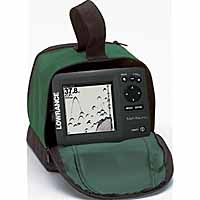 Sonar
Unit; Crappie come near shore during
the spawning season Crappie will
typically spend a considerable time of
the year in deeper water around
submerged structure, brushpiles, or
submerged vegetation. If you have a boat
and want to get serious about catching
crappie throughout the year on a
consistent basis, you really want to
invest in a sonar unit. You can get two
different types. Some portable self
contained units have internal
rechargeable batteries and are ideal for
small boats, rental boats, and canoes or
kayaks. Then you have those that mount
on the console or gunnel of a motorized
fishing boat, drawing it power from the
battery. With this you should be able to
see the bottom terrain, sunken logs,
rockpiles, concentrations of baitfish
and schools of gamefish. Sonar
Unit; Crappie come near shore during
the spawning season Crappie will
typically spend a considerable time of
the year in deeper water around
submerged structure, brushpiles, or
submerged vegetation. If you have a boat
and want to get serious about catching
crappie throughout the year on a
consistent basis, you really want to
invest in a sonar unit. You can get two
different types. Some portable self
contained units have internal
rechargeable batteries and are ideal for
small boats, rental boats, and canoes or
kayaks. Then you have those that mount
on the console or gunnel of a motorized
fishing boat, drawing it power from the
battery. With this you should be able to
see the bottom terrain, sunken logs,
rockpiles, concentrations of baitfish
and schools of gamefish. |
|
Hooking the Minnow; There are
several ways to hook the minnow based on
the type of fishing you plan on doing.
The three ways presented just below are
designed to allow the minnow to stay in
an upright position, providing the most
natural presentation possible.
Float Rigging; If fishing under a
bobber or float, you want to hook the
minnow in the meaty part of the back
near or just behind the dorsal fin. You
must take care to avoid the spine, which
is usually along the lateral line. A
split shot sinker can be placed between
the float and the bobber to provide a
bit more weight for casting and also for
presenting your bait at the desired
depth.
Freelining; You can also free-line
the minnow, meaning you are using no
bobber or float, no sinkers of any kind,
just a hook tied to your line. To do
this hook the minnow near the tail.
Understand however that this type of
rigging will not provide a lot of weight
for casting and if you try and whip it
out as far as possible, the bait will
fly much farther than the hook.
Casting, Retrieving and Slow Trolling;
If you are going to be moving the bait
while fishing it the best hookup is the
lip hook. Hook the minnow upward from
the bottom lip through the top lip. The
lip hookup will also work if you are
going to fish a crappie jig and wish to
sweeten the jig with a live minnow.
|
Bait fishing for Blugills and
other Sunfishes
|
|
|
Catching a sunfish can be as easy as
using a canepole, a length of line, a
bobber and a hook with a worm or ball of
bread and dunking it into the nearest
pond. But for many, there is a pride
that comes with consistently catching
the largest of the species. Often
collectively called "Bream" These
smaller members of the sunfish family do
have slightly different habits, as well
as different tastes in habitats and
preferred food, but the rigging for all
of them is pretty much the same. Their
size, size of their mouths and the size
of their prey pretty much dictates light
tackle or preferably ultra-light tackle.
The bites are sometimes very subtle and
the sensitivity you gain from using 2 to
6 lb test tackle really helps. The same
floats used for crappie will work for
the sunfishes, including the slip float.
As in crappie fishing, there are times
when the best fishing will be in deeper
water. Basically the rigging is the same
as crappie fishing with the exception of
smaller hook sizes. The mouths on these
fish are smaller, requiring smaller
baits, and therfore smaller hooks. Use a
size 6 or 8.
Baits for panfish include a variety of
invertebrates such as worms, mealworms,
crickets, and grass shrimp, as well as
small minnows for some species. Many of
them will also take baits as simple as
small pieces of white bread squeezed
into a breadball. |
|
Sonar Unit; I mentioned these for
use with crappie just above, but they
also come in handy for bluegills and
several other species of sunfish. Other
than the spawning season and just after
when they are feeding to recuperate,
many of the largest fish will be
suspended in deeper water around any
structure they can find.
Good Luck,
Dean Pettit
|
|
|
|
|